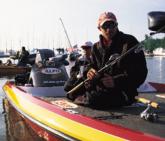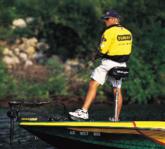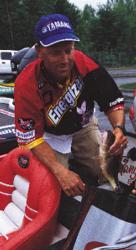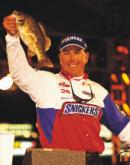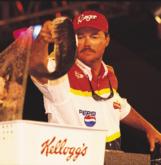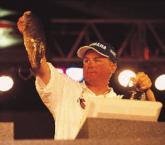I am Sam
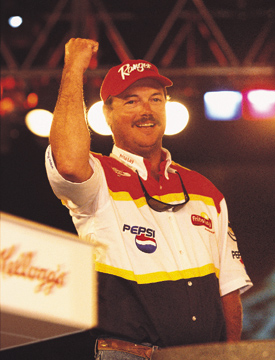
Sam Newby is the toast of Lake Champlain
The day-three weigh-in at the Wal-Mart FLW Tour’s 2002 Forrest Wood Open on Lake Champlain in Plattsburgh, N.Y., had just concluded. Sam Newby of Pocola, Okla., glanced around the tent to size up the other top-10 finalists, which included:
– Dean Rojas, the B.A.S.S. record-holder for a five-bass limit.
– David Dudley, the 2002 Ranger M1 winner.
– Tommy Biffle, an FLW winner.
– Scott Martin, an FLW winner.
– Rick Clunn, a four-time BassMaster Classic and three-time FLW Tour winner.
– Jay Yelas, who had just moments before been crowned the 2002 Land O’Lakes Angler of the Year.
Yet Newby hardly blinked. His face was blank. His eyes were stolid. He appeared unfazed by the caliber of anglers that surrounded him.
If he thought he had a chance to win the Forrest Wood Open, his poker face hid it well. Apathetic to the buzz of commotion and excitement around him, Newby looked like he was ready to go right back out on the water and settle the bass-fishing score.
Conditions
The reason Newby was ready to get back out on the water was because the bass were biting. More importantly, the bass were biting in a way that was very familiar to him, yet somewhat uncharacteristic of Lake Champlain.
Lake Champlain was unusually high and stained June 19-22. Several weeks of heavy rains had brought Champlain’s water up 2 to 3 feet above normal. As a result, there was an abundance of newly flooded shoreline, including stands of partially submerged willow bushes.
Pros reported water temperatures in the high 50s to middle 60s, adequate temperatures for spawning. Some pros dismissed the spawning pattern because of the high water. Additionally, the practice rounds were punctuated with persistent clouds, wind and rain – unfavorable conditions for spotting fish on beds.
During the first two days of the tournament, however, the unthinkable happened: The sun came out, the wind stopped and Lake Champlain slicked off, allowing sight anglers to go to work.
Such conditions allowed Yamaha pro Jay Yelas of Tyler, Texas, to come from 28 points back and take the 2002 Land O’Lakes Angler-of-the-Year title from Kevin VanDam of Kalamazoo, Mich.
“The conditions really played into my hands at Champlain,” said Yelas, who eventually finished ninth in the tournament. “During the first two days of the tournament, the sun was out, the water started to warm and a lot of quality bass started to lock on beds. Everything I weighed in came off beds.”
Patterns
As usual, Lake Champlain fished like a bass factory on steroids. Smallmouth bass could be caught all over the lake; however, largemouth bass helped deal the winning hand.
Chad Grigsby of Colon, Mich., took an early lead with two impressive limits of largemouth bass weighing 19 pounds, 14 ounces and 15 pounds, 6 ounces. The young pro had been flipping fry pods in reeds with a blue Hog Hauler jig.
Grigsby’s largemouth pattern blew out with a stiff 20-mph south wind on day three. Waves crashing into his area turned the water into chocolate milk, and he weighed in only one fish.
Under bright skies and calm waters the first two days, many anglers were able to get out and target spawning smallmouths on offshore flats in 6 to 12 feet of water. Other anglers chose to sight-fish for Champlain’s largemouths in the shallow vegetation.
Sight-fishing patterns dissolved with the high winds on day three, forcing anglers to adapt in order to make the top-10 cut. Those fishing for smallmouths switched to soft jerkbaits and topwaters while those fishing for largemouths flipped the shoreline and willows.
Todd Auten of Lake Wylie, S.C., may be the only top-five angler who did not specifically sight-fish during the tournament. Auten said he was not targeting specific beds as much as he was fishing around bedding areas.
Auten made some big runs on Champlain, running 40 miles to the south on days one, two and four. But no matter where he fished, he stuck to one primary bait: a Zoom Super Fluke.
Fishing in his first FLW Tour event, Auten had located some big smallmouths south of Burlington, Vt. Each day, he would get a small limit of smallmouths close by for security and then make the long run south to cull out his limit with better-quality smallmouths.
“I was keying on small sandy pockets with rock in 5 to 6 feet of water,” Auten said. “Instead of fishing towards the bank, I was making long casts out in the open water in the middle of the pockets with the Fluke.”
Auten rigged the Fluke on a spinning rod with 10-pound-test line. He used a white Fluke when the water was dingy or under cloud cover and a watermelon Fluke in clear water on clear days.
Auten did not go south on the third day when the heavy winds hindered long boat rides. He still managed to catch five bass weighing 16 pounds, 13 ounces near Plattsburgh to make the final cut.
He ran south again on day four but could not catch enough of the better-quality fish to cull out the smaller fish.
Stanley pro Scott Martin of Clewiston, Fla., sight-fished his way into a top-five finish at Lake Champlain. Early in practice, Martin noticed a substantial water temperature difference between the Vermont and New York sides of the lake. The Vermont side, where a lot of fish appeared to be done spawning, was warmer than the New York side, where fish were still on beds.
Martin chose to stay on the New York side of the lake during practice and search for spawners. “I have two GARMIN GPS units in the boat – one on the dash and one in the front deck,” Martin said. “As I looked around in practice, I recorded every bed I saw by just pushing the waypoint button. When the tournament started, I had a hundred beds saved. During the tournament I would just cruise around on the trolling motor and follow my GPS unit on the deck; it would get me back to within 6 feet of each bed. When competitors were in my areas, I could look down and know exactly which bed they were fishing and know where the next bed was located.”
Martin claims that his front-deck GARMIN GPS unit saved him a lot of time that is usually lost trying to line up on landmarks, especially on offshore smallmouth beds.
When fishing the beds, Martin used a spinning rod, 10-pound-test Supermono and a green Matzuo tube that featured big white eyes. He used a 3/16-ounce open hook jig head inside the tube.
Sight-fishing worked well for Martin on days one and two. He caught five bass weighing 16 pounds, 3 ounces on the first day and ran into a bonus 5-pound largemouth on day two, which pushed his second-day catch to five bass weighing 18 pounds, 7 ounces.
When the wind blew hard on day three, however, his sight-fishing pattern was useless.
“That’s when I made the best move of the tournament,” Martin said. “I got on those smallmouth bedding flats and started throwing a bubblegum-colored Matzuo Twitching Shad. The smallmouths would come up out of 12 feet of water to eat it. If I saw a fish chase the pink lure without eating it, I would just flip a tube back out there and catch it.”
Martin survived day three with his soft jerkbait. On day four, he scrounged up a small limit early on a variety of lures, including tubes, topwaters and jerkbaits. A brief calm-weather window allowed him to catch two decent smallmouths off the bed.
Later in the day, he gambled on a largemouth spot. “I caught a 3 1/2-pounder on my first cast and thought, `This is going to be it,'” Martin said. “But I never got another quality bite after that.”
Jim Moynagh of Carver, Minn., found an area in the central portion of Champlain that provided an opportunity to catch both smallmouths and largemouths. Like other anglers, Moynagh sight-fished the first two days.
Early in the day, Moynagh would catch a limit of smallmouths out deep and then move up along the flooded shoreline and docks to flip and sight-fish for largemouths. The first day, Moynagh caught a limit of smallies that weighed 16 pounds. He then moved to the bank and started flipping reeds and docks and caught two quality largemouths that pushed his first-day limit to 18 pounds, 2 ounces.
On the second day, Moynagh caught only two smallmouths before moving to the largemouth bank and finishing his limit by flipping a 1/2-ounce black and blue jig.
On the third day, Moynagh fished for smallmouths until the wind forced him into calmer waters. “I pulled into this bay that I had never been into to get out of the wind,” he said. “I started seeing cruising largemouths up in the cattails. I sight-fished and caught four largemouths and one smallmouth on the third day.”
Moynagh rearranged his strategy on the fourth day by relying on a top-water prop bait. Overcast skies, an early blastoff and slick waters were the right conditions for topwaters, but the fish were small. Later in the day, Moynagh went back to flipping the reeds and caught two decent largemouths that helped anchor his final-day stringer of 14 pounds.
Yamaha pro Dean Rojas of Lake Havasu City, Ariz., contends that Lake Champlain is such an incredible fishery that it can be detrimental during the practice rounds.
“I hear guys say they are going to Champlain a few days early because they want to fish for fun. The way I see it, fishing for fun can get in the way of fishing to win,” Rojas said. “I didn’t go to Champlain to have fun; I went to win the tournament. I would have loved to jerk on smallmouths for fun, but I stayed committed to doing what it takes to win there, which is catching largemouths.”
Instead of tussling around with 3-pound smallmouths in practice, Rojas spent all four of his practice days staking out largemouth beds within 10 miles of the launch site.
On days one and two of the tournament, Rojas caught largemouths off beds. On days three and four, however, his largemouths began to wear thin. “It wasn’t so much the weather that bothered me as much as I started running out of largemouths,” Rojas said.
Rojas was forced to finish his five-fish creel with three smallmouths each of the last two days. He sight-fished for the smallmouths as well.
“The largemouths were spawning up in shallow vegetation, usually around sand, and the smallmouths were spawning out deeper on rocks,” he said.
For lures, Rojas used Lake Fork Tackle tubes and lizards in a variety of colors. He also used a Hog Caller Pollywog. He tied his baits to 20-pound-test Izor line and 3/16-ounce sinkers.
Rojas’ largemouth plan left him just 1 ounce shy of his intended victory, but he is not complaining. After collecting $153,000 on the FLW Tour this season, Rojas said he is happy with his near miss. “I don’t know what else I could have done,” he said. “I fished a flawless tournament, and that’s all I can ask of myself.”
Sam Newby practiced nine days for the Forrest Wood Open. During that time, he saw the rising water come up and flood the shoreline. Newby followed the largemouths as they migrated with the rising water and focused exclusively on them for six days, learning the habitat that they used during different phases of the spawn.
“The first day I was there, I caught about 17 pounds of largemouths on the outside of pencil reeds,” Newby said. “As the water came up, they moved into the cattails behind the reeds. Some of the bass spawned in the cattails. The bass that had spawned then moved into the flooded willow bushes.”
Ultimately, Newby caught a majority of his postspawn largemouths in the flooded willows on days three and four.
To get to the finals, Newby sight-fished for largemouths on day one. On day two, the wind disturbed the reeds where he was sight-fishing and made the water too cloudy to see.
He made a run south to a pocket protected from the wind and began flipping for postspawn fish in the willows. The willow pattern worked, giving him a creel of 16 pounds, 2 ounces.
On day three, wary of the wind, Newby stayed close to Plattsburgh for three hours trying to catch smallmouths. Then he decided to tough it out and make a rough boat ride south to the protected willow pocket he had fished the day before.
“They bit well that day,” Newby said. “The sun was bright, and it had the fish wadded up in the willows.” Newby eventually culled up to 16 pounds, 4 ounces on day three.
On day four, Newby again caught a few smallmouths close and then went to his willow pocket. But after 30 minutes, he was still without a bite.
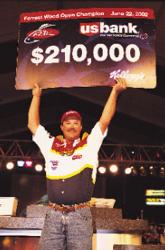 “It was cloudy and overcast that morning, and the largemouths were not eating the jig like they had been,” he said. “I noticed a few fish cruising around outside the bushes, so I switched to a Zoom Fluke (white/blue back). I caught quite a few fish on it but could not get past 13 pounds.”
“It was cloudy and overcast that morning, and the largemouths were not eating the jig like they had been,” he said. “I noticed a few fish cruising around outside the bushes, so I switched to a Zoom Fluke (white/blue back). I caught quite a few fish on it but could not get past 13 pounds.”
Newby was culling up only ounces at a time. In the back of his mind he kept thinking of a place 30 minutes farther south where he had found some largemouths on beds in practice but had not been back to since.
At noon, Newby finally decided to see if the distant bedding largemouths were still there – and they were. The move allowed him to cull up three times and provided his kicker fish of 4 1/2 pounds.
Newby estimates he caught 90 percent of his bass, including the sight bass, on an Ozark Mountains Fishing Lures jig (black and blue) teamed with a Gene Larew Salt Craw.
“Those willow fish are what got me here,” Newby said. “Pitching that jig in the willows was just like fishing on Eufaula (Oklahoma). After the spawn they get tight to those willows on sunny days, and that’s just what they were doing here. Even though I was 2,000 miles from Eufaula, I felt like I was right at home.”
Rick Lisek has won two checks in his FLW Outdoors career: a $400 dollar check at the Wal-Mart FLW Tour stop on Old Hickory Lake near Nashville, Tenn., and a $40,000 check for his first-place finish on the co-angler side of the Forrest Wood Open.
The 24-year-old fiberglass repair shop owner from Springfield, Mo., cashed the biggest tournament check of his life when he weighed in a five-bass limit of smallmouths that registered 13 pounds, 12 ounces at Lake Champlain in June.
Lisek fished with pros Mark Hardin, Scott Martin and Todd Auten during his three days of competition.
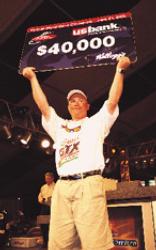 His primary lure was a 1/4-ounce Limitfinder jig (brown/green tinsel) teamed with a Zoom Critter Craw tied to 10-pound-test Stren Fluorocarbon line. On days two and three, he also caught fish on a bubblegum Zoom Fluke and a hand-painted Strike King jerkbait.
His primary lure was a 1/4-ounce Limitfinder jig (brown/green tinsel) teamed with a Zoom Critter Craw tied to 10-pound-test Stren Fluorocarbon line. On days two and three, he also caught fish on a bubblegum Zoom Fluke and a hand-painted Strike King jerkbait.
Lisek looks forward to springing off the co-angler side next season, when he will test the waters of the Northern and Central EverStart Series divisions on the pro side.
